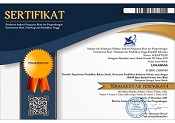WAWACAN SITI PERMANA KARYA M.K. MANGOENDIKARIA (Kajian Struktural dan Antropologi Sastra)
Abstract
Abstract
This research is entitled Wawacan Siti Permana of M.K. Mangoendikaria (A Structural and Anthropological Literature Study). This study aimed to describe (1) the formal structure; (2) the narrative structure; and (3) the elements of the anthropological literature in Wawacan Siti Permana. The data source of this research is the text of Wawacan Siti Permana of M.K. Mangoendikaria. The research employed descriptive method. This study used the technique of literature study. Wawacan Siti Permana tells a story of a beautiful woman, named Nyi Siti Permana. She is the daughter of the Head of Cigereleng Village. Many men are lured by Siti Permana. In the text, there are 10 pupuhs with 526 paragraphs. They are Pupuh dangdanggula, Pupuh Asmarandana, Pupuh kinanti, Pupuh Pangkur, Pupuh Magatru, Pupuh Sinom Pupuh Mijil, Pupuh Maskumambang, Pupuh Lambang, and Pupuh Pucung. There are some of the results of this research. (1) The formal structure of Wawacan Siti Permana consists of guru lagu and guru wilangan of the pupuhs, characters of the pupuhs, and ten sasmitas of the pupuhs. (2) the narrative structure of Wawacan Siti Permana includes (a) a mixture storyline with 18 episodes; (B) five motifs of story; (C) 12 characters of the stories; (D) the background of place, time setting, and background of ambience; (E) the theme of compassion; (F) The colophon of days of the war between Italy and Ethiopia; and (g) no manggalasastra. (3) The elements of anthropological literature are (a) the three aspects of the belief system (religion); (b) two aspects of social organization; (C) the eight aspects of science; (D) three languages, style, and Sundanese babasan-paribasa; (E) four arts; (F) 16 livelihood; (G) six aspects of technological systems. Wawacan Siti Permana contains many important values and cultural wealth of the Sundanese people.
Keywords
Full Text:
PDFReferences
Ahmadi, Anas. (2010). Potret Manusia Indonesia dalam Cerpen “Derabat” Karya Budi Darma: Kajian Strukturalisme Genetik. Jurnal Parafrase, Vol 10, No 01, hal. 40-48.
Astutik, Ika Dwi. (2012). Budaya Jawa dalam Novel Tirai Menurun Karya NH. Dini (Kajian Antropologi Sastra). Jurnal Sapala terbit 2013, Sastra Indonesia-FPBS-UNS, Vol 01, No 01, hal. 0-11.
Istiqomah, Siti. (2015). Fenomena Batu Akik Pada Masa Orde Baru di Masyarakat Gunung Kidul dalam Novel Maya Karya Ayu Utami: Kajian Antopologi Sastra. Jurnal Sastra Indonesia, Vol 4, No 5, hal. 1-10.
Koswara, Dedi. (2011). Racikan Sastra: Pangdeudeul Bahan Perkuliahan Sastra Sunda. Bandung: JPBD-FPBS-UPI.
Mahmud, Kusman K. (1987). Sastra Indonesia dan Daerah: Sejumlah Masalah. Bandung: Angkasa.
Mangoendikaria, M.K. (2009). Wawacan Siti Permana. Bandung: PT Indahjaya Adipratama.
Moriyama, Mikihiro. (2013). Semangat Baru: Kolonialisme, Budaya Cetak, dan Kesusastraan Sunda Abad Ke-19. Jakarta: Komunitas Bambu.
Nazir, Moh. (2005). Metode Penelitian. Bogor: Ghalia Indonesia.
Pradopo, Rachmat Djoko. (2001). Puisi Pujangga Baru: Konsep Estetik, Orientasi, dan Strukturnya. Jurnal Humaniora, Vol XIII, No 1, hal. 55-63.
Putranto, Andi. (2003). Pandangan Masyarakat Gunung Kidul Terhadap Pelarian Majapahit Sebagai Leluhurnya (Kajian atas Data Arkeologi dan Antropologi). Jurnal Humaniora, Vol 15, No 2, hal. 224-233.
Sudaryat, Yayat, dkk. (2007). Makaya Basa Sunda: Pangdeudeul Pangajaran Basa jeung Sastra Sunda. Bandung: Sonagar Préss JPBD-FPBS-UPI.
Suhartono, dkk. (2010). Cerita Rakyat di Pulau Mandangin: Kajian Struktural Antropologi Claude Lévi Strauss. Vol, 23, No 4, hal. 304-311. Jurusan Bahasa dan Sastra Indonesia-FPBS-UNS
Sukmadinata, N.S. (2012). Métode Penelitian Pendidikan. Bandung: PT Remaja Rosdakarya.
Suyatna, A. (2002). Pengantar Metodologi Pendidikan dan Pengajaran Bahasa. Bandung: Departemen Pendidikan Nasional-UPI-FPBS-JPBD.
DOI: https://doi.org/10.17509/jlb.v7i1.3404
Refbacks
- There are currently no refbacks.
Copyright (c) 2016 LOKABASA

This work is licensed under Creative Commons Attribution-ShareAlike 4.0 International License.










